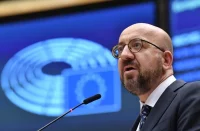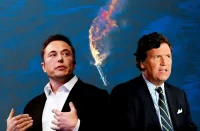The debate on the Treaty of Non-aggression between Germany and the USSR have been deliberately whipped up by the West as an opportunity to lodge various historical, political and even financial grievances with Russia and discredit the country’s foreign and domestic policies. To that end, a series of resolutions were passed between 2006 and 2009 by PACE, the European Parliament, and the Parliamentary Assembly of the OSCE. In these resolutions, the political structure of the USSR in the 1930s and 1940s was compared to the Nazi regime in Germany, responsibility for the outbreak of World War II was placed on both countries, and the date the treaty was signed – 23 August 1939 – was declared the European Day of Remembrance for Victims of Stalinism and Nazism.
Speculation surrounding treaties between the USSR and Germany began immediately after the end of World War II. At that time, the UK and the US needed to justify new plans of aggression against the USSR and divert global attention away from their own collaboration with Nazi Germany. But the greatest demonisation of the so-called Molotov–Ribbentrop Pact was in the final years of the USSR and especially after its collapse. It served as a political tool in the separation of the Baltic States and Moldova from the USSR and then in the acceleration of their accession to the EU and NATO.
So how fair are the evaluations of the Treaty of Non-aggression between Germany and the Union of Soviet Socialist Republics? Was this document any different from other similar agreements of that period? Did it help or hinder bringing World War II to an end? Let’s try to figure it out.
Historical context
When the treaty was signed, the World War II had already started in Europe and had been under way in the world more generally for some time (it was a world war, after all). Since July 1937, an armed conflict had been raging in the Far East between Japan and China, participants in the future world war. Also, in Europe itself, Germany had sent troops into Czechoslovakia (Bohemia and Moravia) on 14 March 1939 in violation of the terms of the Anglo-Franco-German-Italian agreement known as the Munich Agreement on the cession to Germany of the Sudeten German territory of Czechoslovakia. Even earlier, in September 1938, the Cieszyn region of Czechoslovakia was occupied by Poland, acting in collusion with Hitler, and, in March 1938, Carpatho-Ukraine was occupied by Hungary. In early April 1939, Hitler ordered the implementation of Fall Weiss – the plan for the invasion of Poland – the beginning of which was originally scheduled for 25 August that same year.

Against this background, accusing the USSR of initiating the World War II by signing a non-aggression pact with Germany seems strange to say the least. On the contrary, in anticipation of the impending catastrophe, which, by then, everyone knew was inevitable, every country was trying to do what it could to delay its arrival on their soil.
Since 1938, the Soviet Union had actually already been at war in the Far East with one of the future aggressors in the World War II – Japan. So warfare on two fronts did not serve the strategics interests of the country. As such, when another potential aggressor – Germany – approached Soviet leaders and suggested a peace agreement, the USSR’s decision was completely understandable.
Poland had signed a non-aggression pact with Germany in 1934. England and France had signed mutual non-aggression pacts with Germany in 1938. And Estonia and Latvia had formalised relations with Berlin in this area in 1939. Under the circumstances, the action taken by Moscow was not only natural, but logical.
Legal assessment
You have to hand it to Western propagandists, the idea of the Treaty of Non-aggression between Germany and the USSR as a criminal conspiracy between two totalitarian “empires of evil” has firmly entered public consciousness and is actually taken by many as a given. But criminal charges should not be based on emotional factors, but on the specific provisions of international law that were trampled on (“violated”) by the pact between Germany and USSR. Yet, in all these years, no one has been able to provide such evidence. Not a single argument!

From a legal point of view, the non-aggression pact itself is impeccable. Yes, Soviet leaders knew about Germany’s planned invasion of Poland, as did the British, by the way. But there is no provision in international law that would have obliged the USSR in this situation to abandon neutrality and join the war on the side of Poland. It is also important to note that, first, Poland had been pursuing a hostile policy against the Soviet Union and, second, shortly before the pact was signed, Poland had officially refused to accept Moscow’s guarantees for its security.
The pact’s secret protocols, which have been used to all but scare children over the last 30 years, have been a standard diplomatic practice since ancient times to the present day.
The secret protocols were not unlawful in form or substance. There has never been a provision in international law that prohibits states from delimiting their spheres of interest. Otherwise, it would mean that countries actually had the absurd obligation to confront each other on the territory of third countries.
Nor does the delimitation of spheres of interest contradict the principle enshrined in international law of the sovereign equality of all states. The pact did not contain any decisions that were binding on third countries. Otherwise, why would they be kept secret for future implementers? The widespread accusation that Hitler gave Stalin the Baltic states, eastern Poland and Bessarabia in the secret protocols is pure demagogy. Essentially, Hitler could not have handed over something that did not belong to him, even if he had wanted to.
“Progressive humanity”, apparently so concerned with the wrongfulness of the Molotov-Ribbentrop Pact, should pay attention to the UK and the US, which did not divide between themselves the “spheres of interests” in third countries, but the resources in these third countries. “Persian oil… is yours. We share the oil of Iraq and Kuwait. As for Saudi Arabian oil, it’s ours” (Franklin Roosevelt to British Ambassador Lord Halifax, 18 February 1944). PACE, OSCE, the US Congress and others, which have all adopted a number of resolutions condemning the Molotov-Ribbentrop Pact, seem to have conveniently forgotten about this criminal conspiracy.
Moral aspect
The idea that the Treaty of Non-aggression between Germany and the USSR is immoral has been driven into the public consciousness even more firmly than the idea that it is criminal. Politicians and historians talk about the immorality of the treaty almost unanimously, without troubling themselves with the reasons for such an evaluation. It usually all boils down to pathetic statements about colluding with Nazi Germany and Hitler as “the personification of evil”. But here again, we are dealing with deliberate and cynical demagogy.
Prior to 22 June 1941, Hitler was the legitimate and internationally recognised head of one of Europe’s major powers as far as the USSR was concerned. Nazi crimes had not yet been committed when the treaty was signed. Was Germany a likely potential adversary of the USSR? Undoubtedly. But, at that time, France and the UK were also potential adversaries of the USSR. One has only to recall that, in 1940, they were preparing an attack on the USSR to give the world war the character of a European “crusade against Bolshevism” and at least force the Third Reich to go east, thereby saving the war scenario developed by British strategists from collapse.

As can be seen, all of the many accusations thrown at the Treaty of Non-aggression between Germany and the USSR are historically, legally and morally groundless. So why, exactly, is there such hatred for a document that expired 78 years ago (on 22 June 1941)?
A careful analysis and deep understanding of the meaning behind the historical events of World War II provides the answer to this question. The treaty changed the timetable of the inevitable war and the post-war balance of power. It made it impossible for the US and the UK to enter Eastern Europe at the beginning of the war because they had to defend Western Europe. And, following victory, the USSR was already there.
As British Prime Minister Winston Churchill wrote in his memoirs, the fact that such an agreement between Berlin and Moscow was possible meant that British and French diplomacy had failed: they did not manage to direct Nazi aggression against the USSR, and nor did they manage to make the Soviet Union their ally before World War II.














Thanks for this succinct read. I’ve read that there were anywhere from 7 to 19 such military non-aggression treaties in that historical period leading to WW2. The actual number would be useful in terms of putting the 1939 Treaty into perspective.
I think there is another political aspect here that’s missing, however. Both in the immediate post-WW2 period and in the post-Soviet period, there was a common effort to attack the left for different reasons [in these two historical periods.]
In post WW2 Europe, especially, but not only, in France and Italy, the only organized political force that had not been discredited by collaboration with the Nazis, the fascists in Italy, etc., were the Communists. Especially in France and Italy, they had huge popular support. That was simply unacceptable to the Western victors. I would argue that the vilification of the Soviet Union, such as with the nursery tales around the 1939 Non-Aggression Treaty as outlined here, dovetailed precisely with the goal of vilifying the left generally, and the Communists especially, who had such widespread support.
So, too, in the post-Soviet period, and in the changes in public opinion in Western countries, there was a great opening for the left, for peace, and so on. In fact, in South Africa for example, where the Communists had demonstrated heroic dedication over many decades in the anti-apartheid struggle, the membership of the CPSA grew by leaps and bounds in the period leading up to victory over that odious regime in Pretoria.
Yes, the feverish vilification of the Soviets, as today with Russia, and now China, Iran, Venezuela, Syria, etc., had its own independent justification in propaganda terms. As US thinker Noam Chomsky pointed out in regard to Cuba, it is the dangerousness of a “good example”. But the domestic left, especially the European Communists who were the most staunch enemies of the Nazis, were also the target of this same propaganda – to silence them and so on.
This aspect is often trivialized in histories of the post-WW2 period, as though, somehow, the Cold War was a kind of aberration, a mistake even, and not characteristic of the good, liberal West.
I beg to disagree.
Best wishes and thanks again for an enlightening piece.
When you sit down at a cocktail party, with Germania, then you must serve Molotov Cocktails.
This was no doubt planned out, in the late part of the 19th century.
Inorder, to facilitate the needed changes for the Global Agenda.
I must say that it is likely, that Stalin was in on it.
Stalin had a connected background.
The word of a Nazi, is a lie.
When you say Nazi, you Must say, Swiss German Nazi…but don’t forget all the other groups that joined in with
these Degenerates.
It took decades of infiltrating and treasonous acts to prepare.
At the conclusion of this part of the action….Further infiltration and treasonous acts continued.
So todays difficulties have derived from WWII….in fact it is a continuation, and by now, have you figured out who really won.
Financial and Political victory, after loosing on the battlefield, (even when the Nazis had inside help).
This should have taught the Germans that they too were sold out.
Unfortunately Germans have psychopathic tendencies.
Perhaps it will be CERN, that destroys the Planet;
The Human Condition speaks for itself.
I’m a regular reader of your newsletter et your pieces are very informative. I shared your current article on my Facebook page https://facebook.com/faouzi.elmir and on my Twitter @elmir1975
As a Paris based researcher in political science, in History of International relations and geopolitics, i would like to cite somme authoritative references with the main purpose to refute the western conventional historiography which is not but a piece of anti communist propaganda.
(1) The first authoritative reference is the works of professor D.F. Fleming who in his seminal book “the cold war and its origins 1917-1960” T.I refute the western and conventional historiography analyzing the objective conditions of the time pushing Stalin and the USSR to conclude the Molotov-Ribbentrop Pact, 80 years ago on August 23, 1938. A the time, the USSR was not ready militarily to resist the Wehrmacht. There was another element contributing to the Molotov-Ribbentrop Pact, what the western conventional call the “Appeasement”, euphemism to hide the collusion between the french and English leadership with Hitler and the Nazism in order to “liberate” Europe from the “spectre of Bolshevism”
from the same author, “The origins and legacies of WWI” refuting the false comparaison Nazism=communism; Stalin=Hitler
(2) In France, the work of historian Annie Lacroix-Riz, author of several authoritative books dealing with the period of the inter-war and Vichy regime shows how the History become under influence after the WWII and she refutes also the dominant these of western historiography about Molotov-Ribbentrop pact.
(3) According to Alfred Sohn-Reithel, in his book “Ökonomie und Klassestruktur des deutschen Faschismus”, who witnessed the period of the inter war in Germany, the invasion of the USSR had been planned by Hitler since his conquest of power in January 1933 and ordered the military to prepare the war against the USSR as soon as possible
(4) The Italian philosophe,the late Domenico Losurd, in his books “Stalin” in Italien, and “le révisionnisme en histoire” translated from Italian, shows how the current history had undergone décisive shift after the WWI and had been rewriting by historians, the american(ex Pipes) and European historias(ex Furet, Ernst Nolte) in order to fit with the triumphant neoliberalism
(5) In December 2018, I published a book in french “Chimie et politique, rôle des industries chimiques dans les deux guerres mondiales” available on Amazon, (Chemistry and politics, the role of chemical industries during the two world wars) where I expose the role of the United States and its chemical and oil industries(Standard Oil, Dupont etc) in collaboration with the German I.G Farben both in the rise of Nazism and Hitler to power and the militarization of Germany whose main objective was the war against the USSR
for more critical analysis on relationship between the USSR and the, visit my website http://www.siress-editions.com
Many thanks for your interest and high evaluation.